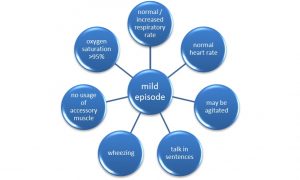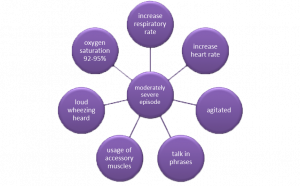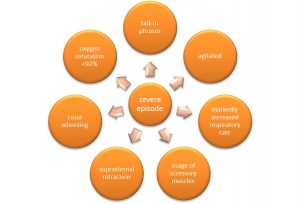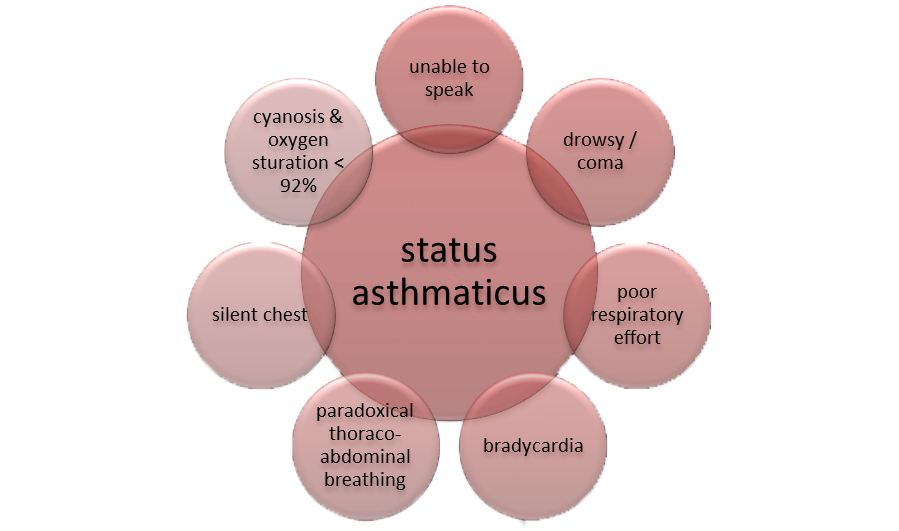Asthma is a common condition caused by narrowing of the small air passages (breathing tubes/bronchi) in the lungs. The narrowing happens because the air passages become swollen and inflamed. This makes it harder for air to get through, and causes wheezing, coughing and problems with breathing.
Common asthma signs
The clinical picture of pediatric asthma varies. Symptoms may be associated with upper respiratory infections (URTIs), nocturnal or exercise-induced asthmatic symptoms, and status asthmaticus.
Status asthmaticus, or an acute severe asthmatic episode that is resistant to appropriate outpatient therapy, is a medical emergency that requires aggressive inpatient management. This may include admission to an ICU for the treatment of hypoxia, hypercarbia, and dehydration and possibly for assisted ventilation because of respiratory failure.
Signs will vary according to the severity of asthma and the severity of any exacerbation.
During episodes, check for:
- Widespread wheeze
(Link to www.youtube.com/watch?v=VA9C_aCH7F0) - Increased work of breathing
See link: http://www.youtube.com/watch?v=Hv68EQ3tCBI - Pulse rate
- Respiratory rate
- Oxygen saturation
- Peak Expiratory Flow rate (PEFR) (in children aged over 5).
- Response to bronchodilator therapy.
Watch Video of asthma signs and symptoms in children:
http://www.parents.com/videos/v/86688973/controlling-and-treating-asthma-symptoms-in-children.htm
Between episodes, there may be no clinical signs but check for:
- Hyperexpansion and Harrison’s sulci

- Signs of atopy or allergic rhinitis, such as conjunctival congestion and inflammation, ocular shiners, a transverse crease on the nose due to repeated rubbing associated allergic rhinitis.
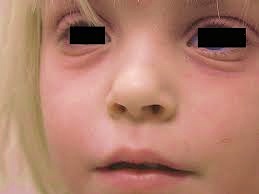
Source: http://realhealthykids.com/wp-content/uploads/2014/02/Dennie-Morgan-Lines2.jpg
- Clues to other possible diagnoses.
Clinical signs in the absence of an acute episode
The physical findings between acute episodes vary with the severity of the asthma. During an outpatient visit, a patient with mild asthma may have normal findings on physical examination. Patients with more severe asthma are likely to have signs of chronic respiratory distress and chronic hyperinflation.
Signs of atopy or allergic rhinitis may be present.
The anteroposterior diameter of the chest may be increased because of hyperinflation. Hyperinflation may also cause an abdominal breathing pattern.
Lung examination may reveal expiratory wheezing, coarse crackles, or unequal breath sounds.
Clinical signs during an acute episode
Physical examination during an acute episode may reveal different findings in mild, moderately severe, and severe episodes and in status asthmaticus with often imminent respiratory arrest.
Findings during a mild episode include the following:
Findings during a moderately severe episode include the following:
Findings during a severe episode include the following:
Findings in status asthmaticus with often imminent respiratory arrest include the following:
In conclusion, parents and caretakers need to know how to evaluate clinical signs of asthma in order to get appropriate management of the child with asthma. Presenting early to emergency department or clinic will prevent the child from developing status asthmaticus.
Asthma education to parents and caretakers is very important in the management of childhood asthma. Asthma action plan should be given to all parents who have a child with asthma.
Reference:
- Ministry Of Health Malaysia. Clinical Practise Guideline For Management Of Childhood Asthma 2014.
- Global Strategy for Asthma Management and Prevention: Global Initiative for Asthma (GINA) (updated 2012).
| Last Reviewed | : | 4 November 2015 |
| Writer | : | Dr. Noor Hafiza bt Noordin |
| Accreditor | : | Dr. Norzila bt. Mohamed Zainudin |
 PENDIDIKAN PESAKIT Kementerian Kesihatan Malaysia
PENDIDIKAN PESAKIT Kementerian Kesihatan Malaysia
